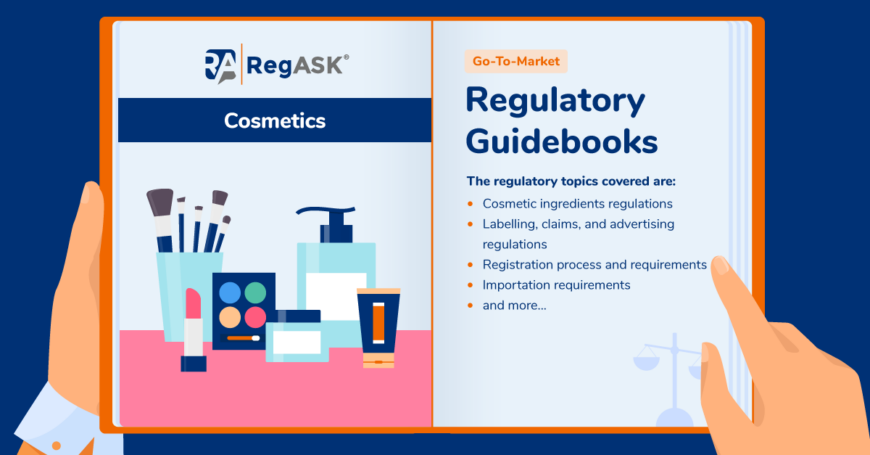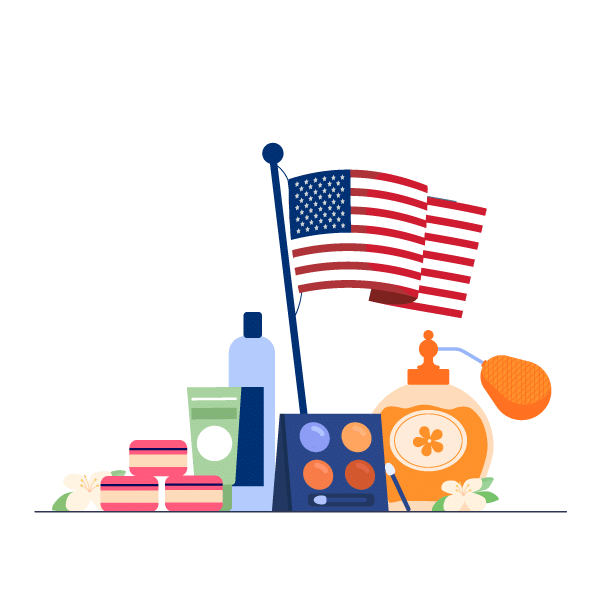The US beauty and personal care market is one of the largest in the world, with an estimated revenue of $91.41 billion in 2023[1]. The market is highly competitive, with a wide range of domestic and foreign companies offering products in various categories, such as skincare, makeup, hair care, fragrances, and personal care.
There are numerous lucrative opportunities for foreign cosmetic companies seeking to enter the US cosmetic market. One key advantage for foreign companies is the ability to bring new and innovative products to the US market, as American consumers are open to trying new products and brands worldwide. Additionally, the US market has a large and diverse population with strong demand and high spending on personal care items. Different regions and demographic groups with varying preferences for cosmetic products present an opportunity for foreign companies to target specific audiences.
Another avenue foreign companies can capitalize on is e-commerce and online marketplaces, which have become increasingly popular in recent years. Companies now have access to a global customer base. They can sell their products on digital platforms like Amazon and Alibaba.
With the right strategies and resources, foreign cosmetic companies can reap huge rewards by entering the US cosmetics market. However, foreign companies must be aware of and comply with local regulations.
The publication in the US of a new regulation, the “Modernization of Cosmetics Regulation Act of 2022,” also called MoCRA, in December 2022 has been breaking news in the US cosmetic landscape.
MoCRA is the most significant expansion of the US FDA’s authority to regulate cosmetics since the Federal Food, Drug, and Cosmetic (FD&C) Act was passed in 1938[2].
The law gives FDA expanded authority in records access and mandatory recall, meanwhile, it establishes new requirements for the cosmetic industry covering areas such as adverse event reporting, facility registration, product listing, and safety substantiation.
requirements for the cosmetic industry covering areas such as adverse event reporting, facility registration, product listing, and safety substantiation.
This new law will trigger significant changes to the current cosmetic regulatory framework, help ensure the safety of cosmetic products and advance innovation for the science-driven beauty and personal care industry[3]. Cosmetic companies seeking to enter the US market must prepare for and adapt to the upcoming big changes.
This article outlines the top 5 things you must know when entering the US cosmetics market. By understanding these factors, you can increase your chances of successfully entering this lucrative market.
Selling Cosmetics in the US: Top 5 Things You Need to Know
1. Cosmetics are not FDA-approved but are FDA-regulated, what does it mean?
US FDA regulates cosmetics under the Federal Food, Drug, and Cosmetic Act (FD&C Act) and the Fair Packaging and Labeling Act (FPLA), the two most important cosmetic laws in the US.
“The law does not require cosmetic products and ingredients, other than color additives, to have FDA approval before they go on the market, but there are laws and regulations that apply to cosmetics on the market in interstate commerce.[4]“
Although MoCRA does not modify the current lists of regulated substances, which include around ten restricted or banned substances and a positive list of dyes, the FDA is anticipated to introduce new proposed regulations related to fragrances allergens, the use of PFAS, and testing methods for detecting asbestos in talc-based cosmetics.
MoCRA pre-empts state law requirements differing from, or in addition to, those relating to registration and product listing, good manufacturing practice, recordkeeping, recalls adverse event reporting, and safety substantiation. Some state laws (such as California’s Prop 65) are pre-empted.
2. Is it a cosmetic, a drug, or both? (Or is it soap?)
“Whether a product is a cosmetic or a drug under the law is determined by a product’s intended use,” according to US FDA[5]. For example, soaps are not classified as cosmetics under the Federal Food, Drug, and Cosmetic Act (FD&C Act); Consumer Product Safety Commission regulates them. Sunscreens are classified as drugs.
How can a product be both a cosmetic and a drug? Some products meet the definitions of both cosmetics and drugs. This may happen when a product has two intended uses. For example, shampoo is a cosmetic because it is intended to cleanse the hair. An antidandruff treatment is a drug because its intended use is to treat dandruff. Consequently, an antidandruff shampoo is both a cosmetic and a drug.
Among other cosmetic/drug combinations are:
- toothpastes that contain fluoride
- deodorants that are also antiperspirants
- moisturizers and makeup marketed with sun-protection claims
Such products must comply with the requirements for both cosmetics and drugs. They are generally designated as Over-The-Counter products (OTC).
3. Are there inter-state differences in cosmetic regulations?
The cosmetic industry in the US is highly diverse, with regulations varying widely from state to state. While some states have strict laws and policies to protect consumers, others are more lenient. These state variations can make it difficult for companies to understand and comply with the different regulations when selling products across states. This can challenge cosmetic manufacturers and retailers looking to expand their business in the US.
There are state-specific regulations. For example, the state of New York has banned the sale of personal care products containing mercury. In California, there are California Proposition 65 (Prop 65), Toxic-Free Cosmetic Act, and California Safe Cosmetics Act (CSCA), and companies need to be aware of these regulations before selling in this state.
In 2020, the state of California signed Toxic-Free Cosmetic Act. The law established that beginning on January 1, 2025, “no person or entity shall manufacture, sell, deliver, hold or offer for sale, in commerce any cosmetic product that contains any of the following 12 intentionally added ingredients.[6]” In February 2023, a list of 26 additional ingredients to be banned was submitted. If passed, the bill would ban the sale of cosmetics containing these compounds, which are linked to negative impacts on human health.
4. Is product registration or pre-market approval required for cosmetic products?
US FDA does not require product registration or pre-market approval or testing of cosmetic products placed on the US market, with the exception of color additives, which makes it easier for foreign cosmetic companies to enter the market. However, with the new upcoming regulation MoCRA, the notification of cosmetic products is required by December 29, 2023. From 2024, notification will be required within 120 days of marketing.
5. Is a responsible person required to sell cosmetics in the USA?
Under MoCRA, a “Responsible person” is defined as the manufacturer, packer, or distributor of a cosmetic product whose name appears on the label.
Its main responsibilities will be to ensure product listing, safety substantiation, cosmetovigilance, notification, and allergen labeling. In addition, the responsible person will have to carry out product recalls or withdrawals, if necessary.
Currently, manufacturers, packers, or distributors are not required to register their cosmetic establishments or file their product information with the FDA. However, as of December 29, 2023, the registration of establishments will be mandatory, whether in or outside the USA. The registration, which will have to be renewed every two years, does not apply to establishments that only perform labeling, packaging, or distribution of cosmetic products.
How RegASK Can Help You Sell Cosmetics in the US
Cosmetic companies entering the US market must be aware of the various regulations concerning their cosmetic products’ safety, labeling, and ingredients requirements to ensure compliance. Companies must take every step necessary to ensure their products meet all local standards and guidelines before being released to the market. Understanding local regulations can help companies avoid costly fines, product recalls, or potential litigation.
To assist cosmetic companies with successful market entry, RegASK has developed Cosmetics Go-To-Market Regulatory e-Guidebooks per market that provide a practical overview of the regulatory landscape and compliance requirements for cosmetic and personal care products per country.

The regulatory topics covered are:
- Cosmetic ingredients regulations
- Labelling, claims, and advertising regulations
- Registration process and requirements
- Importation requirements
and more…
The e-Guidebooks are constantly updated using RegASK’s regulatory intelligence platform RegAlerts. With RegAlerts, cosmetic companies can stay updated on regulatory changes worldwide, proactively adjust their product strategy and always stay ahead of the competition.
Are you looking to sell cosmetic and personal care products in the US? Speak to our experts to get all the support you need.
Have questions on cosmetic regulations?
Speak to our experts
More cosmetics industry reading resources:
- EU Cosmetic Ingredients Ban: Implications for US Companies
- Selling Cosmetics on Alibaba and Amazon: What You Need to Know
- The Growing Importance of Regulations in the Cosmetics Industry, and Why It’s Important to Stay Up-To-Date
References:
[1] Statista – Consumer Market Insights – Beauty & Personal Care – United States
[2] U.S. FDA – Modernization of Cosmetics Regulation Act of 2022
[3] Personal Care Products Council Applauds Inclusion of Cosmetics Regulatory Reform in Consolidated Appropriations Act of 2023
[4] FDA Authority Over Cosmetics: How Cosmetics Are Not FDA-Approved, but Are FDA-Regulated
[5] U.S. FDA – Is It a Cosmetic, a Drug, or Both? (Or Is It Soap?)
[6] Cosmetics & Toiletries – [update] California’s ‘Toxic-free Cosmetics’ Act Signed into Law

